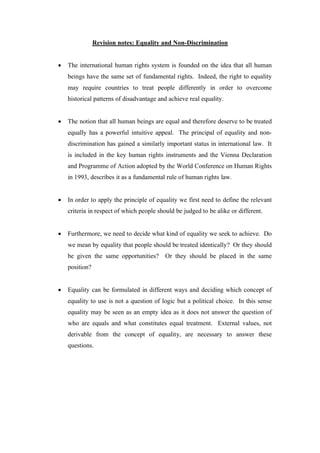
Revision notes: Equality and Non-Discrimination
- 1. Revision notes: Equality and Non-Discrimination The international human rights system is founded on the idea that all human beings have the same set of fundamental rights. Indeed, the right to equality may require countries to treat people differently in order to overcome historical patterns of disadvantage and achieve real equality. The notion that all human beings are equal and therefore deserve to be treated equally has a powerful intuitive appeal. The principal of equality and nondiscrimination has gained a similarly important status in international law. It is included in the key human rights instruments and the Vienna Declaration and Programme of Action adopted by the World Conference on Human Rights in 1993, describes it as a fundamental rule of human rights law. In order to apply the principle of equality we first need to define the relevant criteria in respect of which people should be judged to be alike or different. Furthermore, we need to decide what kind of equality we seek to achieve. Do we mean by equality that people should be treated identically? Or they should be given the same opportunities? Or they should be placed in the same position? Equality can be formulated in different ways and deciding which concept of equality to use is not a question of logic but a political choice. In this sense equality may be seen as an empty idea as it does not answer the question of who are equals and what constitutes equal treatment. External values, not derivable from the concept of equality, are necessary to answer these questions.
- 2. Formal Equality The idea of equality raises the question of when two cases are said to be alike. It is inevitable that laws and government action classify people into different groups that are in turn treated differently. For example, under a progressive taxation system people are treated differently (charged more or less tax) according to their income. In countries with a juvenile justice system people are treated differently according to their age. These distinctions are seen as perfectly legitimate because they are based on morally acceptable grounds. Substantive Equality There are two main variants of substantive equality: equality of opportunity and equality of results. According to equality of opportunity and equality of results true equality can only be achieved if people are not only treated equally but given the same opportunities. Like competitors in a race, everyone should be able to begin from the main starting point in order to make the race fair for each individual competitor. Equality of opportunity requires removal of barriers to the advancement of disadvantaged groups. Such as age limits for employment which may disadvantage women who wish to start a family. Equality of results goes further then equality of opportunity and aims to achieve an equal distribution of social goods such as education, employment, healthcare and political representation. It recognises that removing barriers does not guarantee disadvantaged groups will in fact be able to take advantage of available opportunities. Abolishing age limits for example will not
- 3. guarantee that women with childcare responsibilities will be able to find employment. Equality of results can be understood and achieved in different ways. In its strongest form, it explicitly aims to increase the representation of disadvantaged groups in educational institutions, employment. Or public office through preferential treatment and quota systems. The right to equality and non-discrimination gives concrete expression to the basic idea on which the whole international human rights system is founded: that all human beings, regardless of their status or membership of a particular group, are entitled to a set of rights. Since it underlies all other human rights equality is often described not only as a ‘right’ but as a ‘principle.’ Universal Declaration of Human Rights (UDHR): “All human beings are born free and equal in dignity and rights.” Article 26 ICCPR provides: All persons are equal before the law and are entitled without discrimination to the equal protection of the law. In this respect the law shall prohibit any discrimination and guarantee to all persons equal and effective protection against discrimination on any grounds such as race, colour, sex, language, religion and political standing or any other opinion of national or social origin, property birth or other status. Positive Action As with any other human right the right to equality and non-discrimination entails state obligations of different types. The obligation to respect requires state to refrain from any discriminatory action and to ensure that all the laws and practices comply to prevent discrimination by non-state actors. According to the consistent jurisprudence of the UN treaty bodies, this means countries must introduce comprehensive legislation prohibiting discrimination
- 4. in fields such as employment, education, healthcare, housing and the provision of goods and services. Summary The concept of equality and non-discrimination in eternal human rights law has evolved significantly since the adoption of UDHR. Detailed legal standards have been drawn up and human rights bodies and courts have developed a rich jurisprudence, giving concrete substance to the notion of equality. The most important challenge, however, is to ensure that every human being is in fact able to enjoy their right to equality. In a world in which the average income of the richest 20 per cent is 50 times that of the bottom 20 per cent and the 500 richest people earn more then the poorest 416 million, equal rights remain an unfulfilled promise for large sections of the population. A key component states that all people can participate on an equal basis in all areas of economic, social, and political life including the very decisions of how equality should be realised in all areas of life for every person. Further reading: Human Rights Law – Oxford Press. Rupinder K Gill
